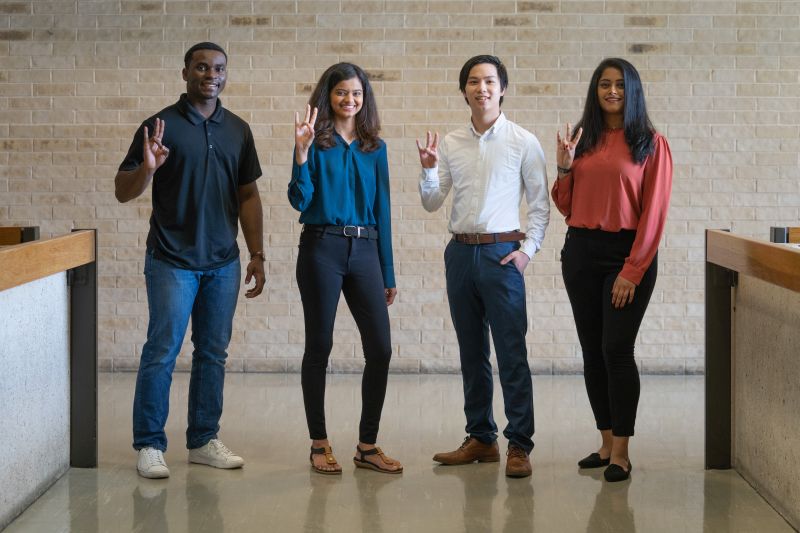A four-person team of students at the University of Houston's Cullen College of Engineering has won a pair of awards for their project – a soft robotics exoskeleton – after presenting at the Excellence in Senior Design competition, held virtually by the University of Texas at Dallas on May 21.
Competing against 12 other universities and colleges, the TrueStep project by Rukaiya Batliwala, Arnold Emeh, Tanvi Parikh and Anthony Pham took first place in the category of Texas Instrument's Best Engineering Design Award. The group also received the Out of the Box Award. Batliwala, Pham and Parikh are Mechanical Engineering students, and Emeh is an Electrical Engineering student.
Batliwala said the presentation was the culmination of a year's worth of work. Presentations were done via Zoom, and they were watching together as a group for the awards ceremony afterward.
“After a few honorable mentions and awards, we won the Out of The Box Award for our unique and feasible design solution,” she said. “We were very excited that we at least brought back one award back home to UH. However, it was an absolutely electrifying moment when our project was awarded first place for the Texas Instrument’s Best Engineering Design, the top award of the evening.”
TrueStep is a soft robotics exoskeleton that provides walking assistance to people suffering from foot drop, a medical condition where an individual cannot lift the front part of their feet due to weakness in dorsiflexion muscles. The condition is usually caused by stroke, spinal cord injuries, or other neuromuscular diseases.
“Our team developed a wearable robotics device that uses Inertial Measurement Unit (IMU) sensors to detect the gait of a person when they are walking, and lifts their foot whenever assistance is needed during their gait cycle,” Batliwala said. “The device weighs only one kilogram, which is 80 percent less than other such devices available on the market. The unique specification of our device is that the patients themselves can wear it at home and use it without any clinical assistance.”
Batliwala noted that their team consists of mechanical and electrical engineering students, and in the initial part of their project, they consulted two industrial design students – Catherine Cunningham and Jazmin Samanez – from the College of Architecture to help us with the ergonomics of our design.
The research advisor for the project was Jose Luis Contreras-Vidal, PhD., Hugh Roy and Lillie Cranz Cullen Distinguished Professor of Electrical Engineering and the Director of the BRAIN Center. The capstone professors were Christiana Chang, Ph.D., and Yi-Chao Chen, PhD., from the Mechanical Engineering Department; and Shin-Shem Steven Pei, Ph.D., and Leonard P. Trombetta, Ph.D., from the Electrical Engineering Department.
“It was a pleasure to work with the team,” Contreras-Vidal said. “We met virtually and they were always well prepared, inquisitive, creative and highly motivated to succeed in this project with a high societal impact … They came to my lab to work on prototypes as their system required 3D printing of housings, and interacted with my grad students. Rukaiya was an effective team leader, and the other team members – Tanvi, Arnold and Anthony – did a great job in accomplishing their engineering tasks, learning about the state of the art, the clinical population, and the role of engineering on society.”
Trombetta watched the presentation, and he was impressed by the students, as well as the camaraderie shown by all of the teams participating.
"I can attest that they made a terrific presentation at the conference, and that a lot of people were interested in their work," he said. "In fact, there were 12 student teams from around Texas making presentations, and I was impressed that they were all very supportive of one another. There were lots of comments from various teams in the chat section during the awards ceremony showing support for each other. Very heartening!"
